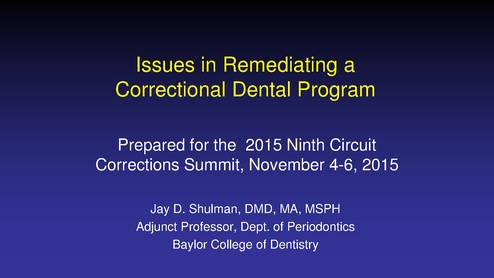Issues in Remediating a Correctional Dental Program, Shulman (9th Cir Corrections Summit), 2015
Download original document:

Document text

Document text
This text is machine-read, and may contain errors. Check the original document to verify accuracy.
Issues in Remediating a Correctional Dental Program Prepared for the 2015 Ninth Circuit Corrections Summit, November 4-6, 2015 Jay D. Shulman, DMD, MA, MSPH Adjunct Professor, Dept. of Periodontics Baylor College of Dentistry Objectives • Describe dental needs of correctional population • Components of an adequate dental program • Issues related to remediating and monitoring based on experiences with Fussell and Perez Settlement Agreement Selection and responsibilities of monitors Determining when substantial compliance is achieved A Perfect Storm for Dental Disease • More dental disease than free population • Substantial pre-existing needs Prisons take inmates as they are, not as they wish them to be Staffing should accommodate high prevalence of dental needs • Caries – risk factors: diet, substance abuse, polypharmacy Many drug classes cause dry mouth which promotes decay • Periodontal disease – risk factors diabetes, poor oral hyg. • Edentulism – high prevalence of tooth loss • Oral cancer – risk factors: race, tobacco, age Adequate Dental Program • “Consistent with generally accepted professional standards … not limited to extractions … timely” • Diagnosis: caries, periodontal disease, oral cancer • Treatment should include continuum of care: Extractions, fillings, removable dentures and limited periodontics Urgent care (toothaches) – timely pain relief Routine – untimely treatment may result in tooth loss Pain relief when clinic is closed (access to mid-levels) Systemic Issues • Care adequate in quality and quantity Diagnosis consistent with professional standards Scope of care - basic dental needs (a prison is not a health spa) Institutional (public health) versus private practice model • Timeliness (requires adequate access) Toothaches – pain relief and treatment by dentist Understaffed programs focus exclusively on toothaches • Qualified providers (dentists, hygienists, assistants) • Adequate policies and procedures Settlement Agreement • Process for selecting dental experts / monitors • Process for dealing with expert disagreements • Chief Monitor in multi-disciplinary cases? Stand-alone dental, health care, or conditions of confinement Fussell (Ohio) versus Perez (California) models • Reporting requirements for experts • Coordination with other cases (e.g., Perez) Settlement Agreement (cont.) • Specify resources, personnel and organizational structure • Process to develop audit instrument • Implementation timetable Deviations require explanation Phased implementation for large systems • Specify ‘goal posts’ (or a process to develop them) • Operational definition of substantial compliance based on audits and other mandated changes Audit Instrument • Based on policies and procedures; approved by parties Cast elements into binary questions Several sections with different passing scores • Agreement as to passing scores for each section • Clear record selection rules • Process for test audits and adjustments Time consuming – may require several iterations • Written report to parties Experts / Monitors • Must have confidence of parties and Court An evolutionary process • Must not lose sight of role – goal is an adequate, not a perfect system • Be prepared to serve as consultants to program if asked • Should have ‘reasonable’ access to: Reports and facilities Dental providers (including contractors) Custody (to look at pass system, escort process) Perez / Fussell Remediation Lessons • Two experts – one nominated by each party • Initial contentious phase (“getting to acceptance”) • Stable, experienced program leadership who are dentists • Collaborative approach among experts and parties Extensive interaction between experts and program leadership • Critical that there is no disagreement over ‘facts’ Program staff participate in prison visits and audits Opportunity to review draft reports (to identify inaccuracies)

